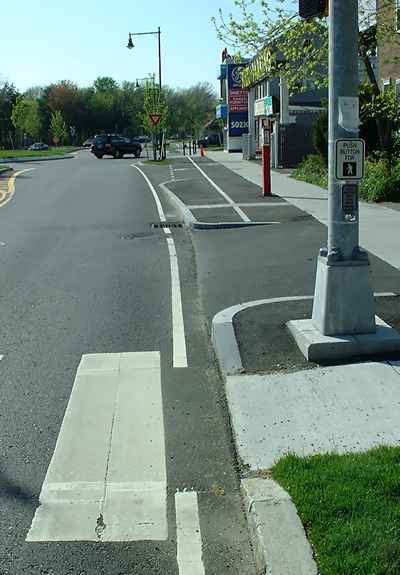
Top: Home Page
Up: Table of Contents
Previous: Path in Fresh Pond Park
Next: additional comments
Let's start out here with quotes from two prominent figures in the world of bicycling
advocacy. John Forester's and Andy Clarke's opinions about bikeways are generally as
different as Ted Kennedy's and Pat Buchanan's views on welfare reform. Forester advocates
and teaches road cycling; Clarke advocates for separate bicycle facilities. Forester and
Clarke disagree on so much about bikeways that it is remarkable when they do agree. They
agree about sidepaths.
As Clarke notes, the AASHTO (American Association of State Highway and Transportation Engineers) bicycle facilities guide strongly counsels against sidepaths. It has done so in every edition since 1981. Crash rates for sidepaths which are crossed by streets and driveways have been shown to be much higher than for riding on streets, in one research work after another. Sidepaths which require bicyclists to ride facing traffic have been shown to be especially dangerous (For details, see Web pages about sidepaths on this site). Here's another interesting quote:
In spite of all this, in early May, 2002, Cambridge, Massachusetts has somehow experienced a time-warp back to the 1970s. A two-way bicycle sidepath/sidewalk has been constructed between the two rotary intersections (traffic circles) on Concord Avenue in Cambridge. The sidepath crosses 7 commercial driveways and two streets within its length of less than 1/4 mile. Tour de sidepathLet's take a tour of this sidepath, from east to west. The sidepath begins at a crosswalk (location J in aerial photo). As shown in the photo below, eastbound cyclists must cross Concord Avenue at the crosswalk to continue legally on its right side. All cyclists must make their way around a fire alarm call box and lamppost, and either hop over curbs which intrude into the width of the sidepath, or else ride on the adjacent sidewalk (light-colored pavement). |
East end of the sidepath at crosswalk

| The pushbutton-actuated signal at the crosswalk will delay cyclists, and therefore
many will ignore it. Eastbound road traffic enters from the rotary and from a gas station
just out of the picture to the left. For this reason, cyclists crossing against the light
will not be able to determine when there will be conflicting traffic. Other eastbound
cyclists will decline to cross Concord Avenue, and instead will continue on the left
sidewalk., a hazardous behavior; the sidepath is also hazardous, because it also is a left
sidewalk, except that this hazardous behavior is officially sanctioned. In the background of the photo, at the base of the overhead streetlight, the right curb of Concord Avenue has been bulbed out to force vehicles to slow and turn right as they enter the rotary, rather than proceeding straight. Bicyclists traveling on the roadway do best to enter the rotary by merging somewhat to the left, as described in the section on rotaries in Bicycling Street Smarts. We now move forward along the path. The photo below looks west past the Sozio appliance store on the corner of New Street (location K in aerial photo). The sidepath merges into the sidewalk here to make room for right-turning traffic exiting the rotary into New Street. The row of poles in the foreground is intended (according to Michael Halle of the Cambridge Bicycle committee) to prevent motor vehicles from crashing into the Sozio store, though the poles are clearly not sturdy enough to accomplish that; and neither are they a standard guardrail, with a smooth surface the would deflect rather than capture a vehicle. The also direct bicyclists to continue on the sidepath toward a crosswalk. Cyclists traveling in the direction the camera is looking have to look back over their shoulder and guess whether vehicles in the rotary are going to turn right and if so, whether they will yield. At the same time, the cyclists have to look ahead into the crosswalk and to their right as they pass the blind corner of the store. The curb cut on the near side of the crosswalk is of wheelchair width and forces bicyclists to ride close to the blind corner at the storefront. The curb cut on the far side of the intersection is not much wider. |
View of Sozio appliance store and smaller rotary
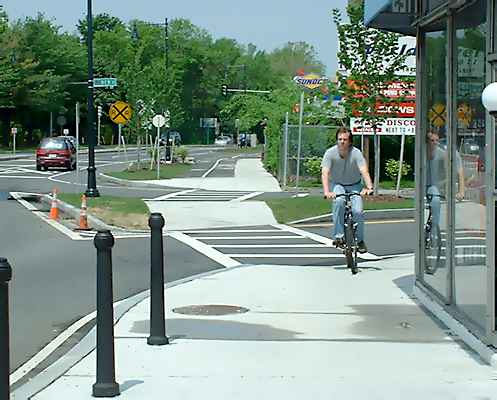
| Let's follow that bicyclist: he passed the camera location and then swerved out into the street to avoid the wait at the crosswalk. He appears twice in the time-lapse panoramic photo below. His nonstandard and hazardous shortcut is typical of those encouraged by bicycle facilities which increase travel time. |
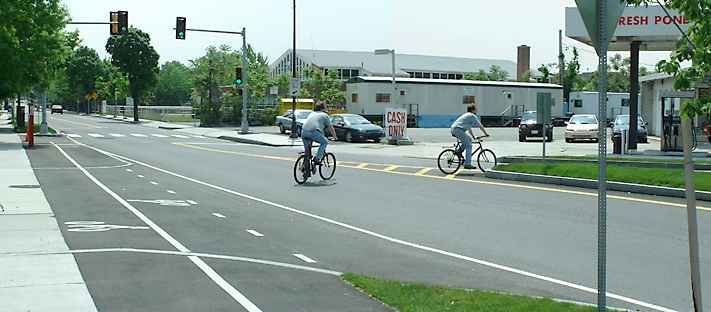
| Another bicyclist (below) coming from the same direction either did not know that he could have used a path on the other side of Concord Avenue, or he chose a faster route. He went around the rotary the wrong way and then rode facing traffic on the sidewalk past the gas stations. The sidewalk is not designated as a bicycle path, but it is popular for travel in both directions. |
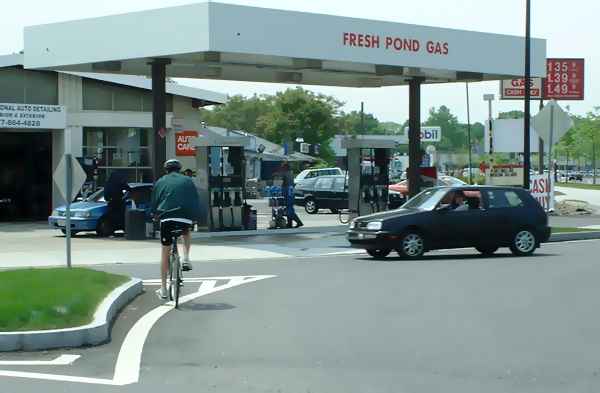
| .We now move across New Street. The photo below looks back across New Street from west to east. The traffic island channelizing and directing the incoming traffic makes this traffic circle into what is technically called a "roundabout". The traffic island which separates the two directions of traffic on New Street is a good feature for a crosswalk, as crosswalk users need deal with only one direction of traffic at a time. |
View of Sozio appliance store and smaller rotary

| However, the blind corner in the foreground of the photo is deadly. By
far, the most common collisions between motor vehicles and cyclists on sidepaths occur
when the cyclists are entering a crosswalk on the left side of the intersection (from the
position of the camera). The collision rate for this type of conflict is approximately 10
times as great as when bicyclists are riding in the normal position on the right side of
the roadway. Motorists such as the one in the car closest to the camera are looking left
for traffic as they prepare to enter the intersection. The fence and vegetation at this crosswalk seriously worsen the hazard. As the photo shows, motorists can not see very far into the sidepath/sidewalk until the front of their vehicle is past the stop bar. A vehicle with a long hood would intrude into the crosswalk before the driver could see into the sidepath. According to Michael Halle, the City is working with the owner of the property to get the fence and vegetation removed, but this measure does not overcome the fundamental fault of the design. The traffic cone in the foreground covers a lamppost base, which is to be removed. The lamppost was at the previously near the edge of Concord Avenue, which has been substantially narrowed to make room for the sidepath/sidewalk. Turning around at the same location, we look across the driveway of the Adams Fireplace and Stove company, then the railroad crossing of the Watertown Branch rail line. The railroad crossing is equipped now with an expensive new rubberized crossing, for the benefit of the one business in Watertown that still takes deliveries by rail. The rail line from the other side of Concord Avenue southwest into Watertown may some day be designated as a rail trail, a more productive use than that to which it is currently being put. |
Sidepath passing Adams Fireplace and Stove and rail line
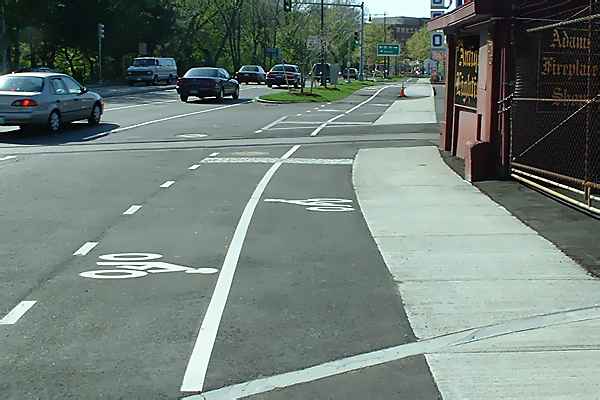
| Beyond the rail line in the photo is the entryway for a Sunoco gas
station (location L in aerial photo). Part of the project that
includes the sidepath is the narrow median which has been installed on Concord Avenue
(left side of photo). The median prevents motorists from turning left across the sidepath
from the far side of Concord Avenue, though they may still turn right across it when
entering or leaving entryways. The median is not wide enough to shelter a bicycle at the
crosswalk. Riding through the rotaries on Concord Avenue has been intimidating for all but skillful, adult bicyclists in recent decades. However, changes have been made so that bicycle and motor traffic interfere with each other more than before. In order to make room for the sidepath/sidewalk and an unusually wide grass strip, Concord Avenue has been narrowed. The outside lane is no longer wide enough for side-by-side bicycle/motor vehicle lane sharing. This change, which runs contrary to Massachusetts Highway Department guidelines, has made bicycle travel on the roadway less convenient, and strongly encourages use of the sidepath. Now we move ahead to the gas station entryway. We are looking across the sidepath at a mid-block crosswalk, which is part of the designated bicycle route along Concord Avenue. Eastbound bicyclists must cross two pushbutton-operated crosswalks to make their way long Concord Avenue. The same appears also to be the case for westbound bicyclists. Delays to motorists and bicyclists alike are increased substantially by these crosswalks. Note also the right-angle turns and curbs at the crosswalk. These are contrary to AASHTO guidelines for bicycle facilities. The stone rumble strip immediately before the crosswalk is apparently intended to alert bicyclists that they are about to cross the entrance from of the crosswalk. Pedestrians are in theory supposed to cross the sidepath here to use the concrete-paved sidewalk that runs adjacent to it. Perhaps the idea is that the bicyclists are supposed to yield to the pedestrians? As a bicycle traveling at 15 miles per hour has a stopping distance of typically 40 feet or more, the placement of rumble strips next to the crosswalk exit is pathetically incompetent. |
Crosswalk in front of Sunoco gas station

| The great width of the sidepath and adjacent sidewalk, and the grass strip, are taken
out of the width of the travel lanes -- and of the median, which is pitifully narrow, so
that it can not provide a place of refuge for a bicycle, or even a pedestrian. There is
also no pedestrian pushbutton at the median, and so a person caught here when the light
changes is trapped between two streams of traffic on one of the most heavily-used commuter
routes in the Boston area. This is a Metropolitan District Commission roadway. The Metropolitan District Commission already has had long experience with an inadequate median at the Cambridge and of the Harvard Bridge, but nonetheless created an even narrower median here. A pedestrian was seriously injured at this crosswalk only a few weeks after it was installed. The pedestrian crossed the inner lane and was struck by a vehicle overtaking in the outer lane. |
Narrow median at crosswalk
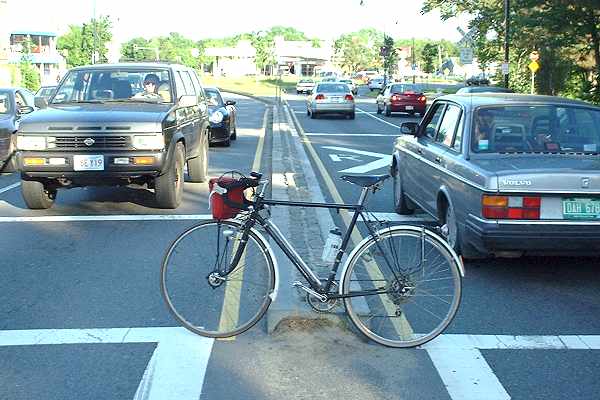
| We move ahead to the entryway for a Dunkin' Donuts shop. Pass your mouse cursor over the image and get a surprise!! |
Path at Dunkin' Donuts entryway.
| Many bicyclists will get the same surprise you have just had. Keep in mind that the
photos were taken on a Sunday, at a time of light traffic. During weekday commute times,
traffic on Concord Avenue is very heavy. The new signalized crosswalks will cause traffic
to back up even more than in the past. Bicyclists will frequently be traveling faster than
the motor traffic. Motorists about to turn right into the entryways will often fail to
notice bicyclists who are approaching in their right rear blindspot. Na´ve bicyclists
will gain a false sense of security from the sidepath and will not realize that they have
to proceed slowly and look back over their left shoulder at every crossing. Now we advance to Concord Lane (location M in aerial photo), a minor two-way street which crosses the sidepath. This street carries considerable traffic, as it provides a shortcut to and from the Fresh Pond Mall parking lot. Notice the nonstandard crosswalk markings, with a dashed line at the street side. The next entryway, in the background, leads to the Best Western Hotel on the corner of Concord Avenue and Alewife Brook Parkway. The same conflicts with entering and turning traffic occur at these crossings as at the others. The trunks of the trees planted in the grass strip will increasingly obstruct sight lines as the trees grow. |
Sidepath crosses Concord Lane
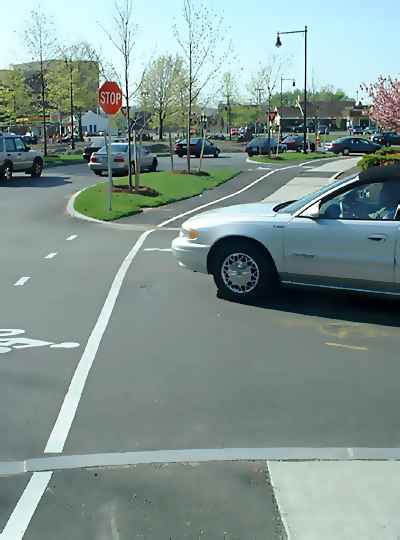
| The new section of sidepath ends at a very wide entryway into the parking lot of the Best Western hotel on the corner of Concord Avenue and Fresh Pond Parkway (location N in aerial photo). The angle of the sidepath out toward the street suggests that it may be intended to direct bicyclists onto the street, or onto an additional crosswalk which has not yet been constructed. Alewife Brook Parkway has wide outside lanes, but only cyclists headed north (away from the camera) can conveniently and lawfully get from the sidepath to the Alewife Brook Parkway. Bicyclists who did not know that they could cross at the crosswalk to continue on Concord Avenue have been seen to enter the rotary here, and they must cross the two exit lanes without any opportunity to merge. |
End of new sidepath segment at wide entrance to Best Western parking lot
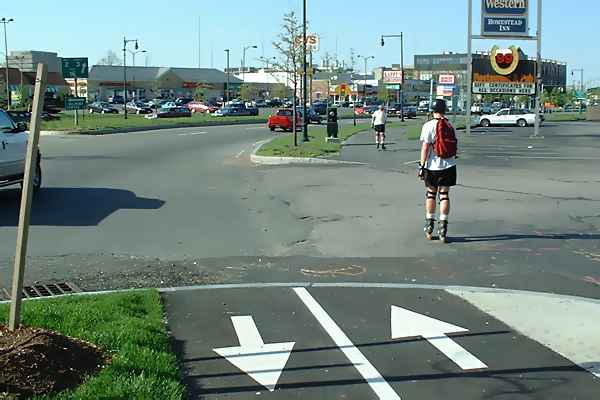
| On the far side of the wide entryway, an older section of sidepath continues. Though
that section is 10 feet wide, it has curb cuts of only wheelchair width, like the one
shown at location E in the photo below. Narrow curb cuts like these are used throughout
the Alewife Brook Parkway project. As of May 5, 2002, no crosswalk markings had been
painted across the entryway -- it may be outside the project limits. I regard the wide Best Western crossing as the most hazardous one on the sidepath. The photo below shows this crossing from the Alewife Brook Parkway end. Motorists may cross the sidepath from any of three directions, A, B and C in the photo. The crash risks are different depending on where the motorists start. |

What were they thinking?The City of Cambridge, the Metropolitan District Commission and the Massachusetts Highway Department all had a hand in this project. I do not know who was ultimately responsible for the decision to narrow the roadway and to build a sidepath. The project clearly reflects some of the newer trends in design of rotary intersections, in particular, the use of center dividers at the entries, making the intersections into what are technically called "roundabouts". Narrowing the traffic lanes and channelizing the traffic is intended to slow traffic and control the direction from which vehicles enter the rotaries. Bicycling through this area was never comfortable for unskilled bicyclists; channelizing the traffic would still have been possible without narrowing the roadways, which worsens bicycling conditions. The project designers appear to have thought that they were solving the resulting problems for cyclists by building sidepaths and crosswalks so that cyclists would never have to travel on the roadway. I can speculate that the opinions of Cambridge bicycle coordinator Cara Seiderman played a part in the decision to install crosswalks across Concord Avenue. Instead of crosswalks, bicycle/pedestrian overpasses have been installed in the past at other crossings of heavily-traveled roadways in the Boston area, notably Storrow Drive along the Esplanade in Boston, and Memorial Drive at Magazine Street in Cambridge. As I learned during my time on the Cambridge Bicycle Committee, Seiderman dislikes overpasses, for a reason which I speculate to be that overpasses encourage more motor vehicle use and confirm the status of the roadway as a place where pedestrians are not welcome. What should have been done?In my opinion, crosswalks make very good sense for pedestrian crossings of ordinary city streets, but overpasses make more sense for crossings of major arterial highways, where traffic is already very heavy and is not otherwise controlled by traffic signals. Concord Avenue between the two rotaries is part of a heavily-traveled arterial highway, Massachusetts Route 2; and despite the absence of traffic signals in the rotary intersections, traffic jams were already frequent here before the reconstruction. Yes, pedestrian overpasses would have been more expensive than crosswalks, but in the long run, they would pay off through reduced injury and fatality rates, reduced delays to pedestrians and motorists alike, and reduced air pollution. I made this opinion clear when I was a member of the Cambridge Bicycle Committee, but my position was not adopted. And how should bicyclists have been handled in this project? As I stated before, the two rotaries on Concord Avenue were not very bicycle-friendly before the reconstruction. However, some bicyclists still chose to ride through them in the vehicular traffic flow. That option might have been made easier by a redesign which took bicycles into account. But instead, that option has been seriously compromised by the narrowing of Concord Avenue in order to build a sidepath. A two-way sidepath with numerous street and driveway crossings is in in any case the most hazardous type of bicycle facility known. Nobody who seriously considered the safety literature [see examples] would have built a sidepath here. It is a serious indictment of the designers and public officials who planned this project that they included a sidepath. The narrowing of the roadway on Concord Avenue is inconsistent with the usual Cambridge policy of including bike lanes in new projects, and with the widening of Alewife Brook Parkway from the Concord Avenue rotary to Rindge Avenue that occurred in a different project in the mid-1990s. Bicyclists headed from Concord Avenue onto Alewife Brook Parkway do not have to cross any lanes of traffic, and if Concord Avenue had not been narrowed to build a sidepath, this would be an easy, fast trip. Now bicyclists who choose to ride on the road must share a narrow lane with motor vehicles which they either impede, if the traffic is light, or which impede them if traffic is heavy. Bicyclists and motorists alike are impeded by the new signalized crosswalks. If overpasses had been built, many bicyclists would have chosen to use them. As the location of an overpass, unlike that of a crosswalk, is not constrained by the need to provide room for traffic queues, overpasses could have been located so that any paths connecting them were on the south side of Concord Avenue, where there are no entryways. If no overpasses and no sidepath had been built, and the roadway had not been narrowed, things would in any case not be any worse for bicyclists than they were before the reconstruction, and no liability risk would have been incurred by constructing a new, hazardous facility which conveys a false sense of security. What might still be doneThe sidepath should be de-designated as a bicycle facility, in order to reduce liability exposure in crashes which occur on it and to reduce animosity of motorists toward bicyclists who ride on the roadway. Concord Avenue should be widened to allow bicycle/motor vehicle lane sharing. Overpasses should still be considered. There are additional routes through the area. In particular, New Street connects with the north end of the Fresh Pond shopping center. A new underpass which was added during the reconstruction of Alewife Brook Parkway (see pages about Alewife area) provides access between both sides of the Parkway, though the route to the underpass through a parking lot could stand improvement. These routes serve most of the trip generators that the sidepaths along Concord Avenue and Alewife Brook Parkway are intended to serve, and also connect to Danehy Park, with its bicycle path to Sherman Street. In addition, there is a plan to build a bridge over the railroad tracks at Smith Street west of Alewife Station. Once this bridge is built, it will provide another route between Concord Avenue and Alewife Station. Also see: |
Top: Home Page
Up: Table of Contents
Previous: Path in Fresh Pond Park
Next: additional comments